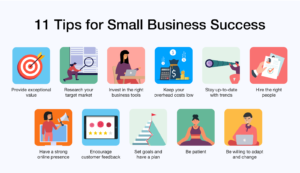Running a small business can feel chaotic and overwhelming. There’s so much to do in a day that it often feels impossible to get all the things done. Mastering effective time management strategies and techniques is crucial to ensure consistent progress on impactful business tasks. In fact, a recent survey revealed that a staggering 90% of respondents believe that improved time management directly translates to heightened productivity levels.
If you’re tired of constantly wishing for more hours in a day, try following this 10-step guide and downloading our free time management worksheet to help you regain control of your business and of your time.
The 3 Fundamentals of Effective Time Management
Effective time management does not involve adding more hours to your day. To be effective at managing your time and making progress on the most important things that will set your business up for success, it comes down to 3 principles:
1. Prioritization
To manage your time effectively, you need to prioritize what’s more important and allow the less important priorities to be delegated, deferred, or ditched. This requires being deliberate about your vision, your strategy, and the big picture. Once your vision is clear, you can prioritize the things that will help achieve that vision, and avoid the things that are distractions.
2. Focus
Once you’ve prioritized the things that will align you to your strategic vision, you need to learn to be comfortable saying NO to the things that won’t get you there. Stay focused on what’s most important.
3. Discipline
You need to be disciplined and leverage systems and processes to remind yourself of your strategy, prioritize what’s important, and review what’s working and what’s not, and stay focused by saying NO to the things that are distractions.
Techniques to help you prioritize, focus, and stay disciplined:
Once you’ve mastered the 3 principles above: prioritizing, focusing, and staying disciplined, you’re on your way to effective time management. The rest is about applying various techniques to make the process easier. Here is a 10-step plan with productivity techniques to help you manage your time effectively:
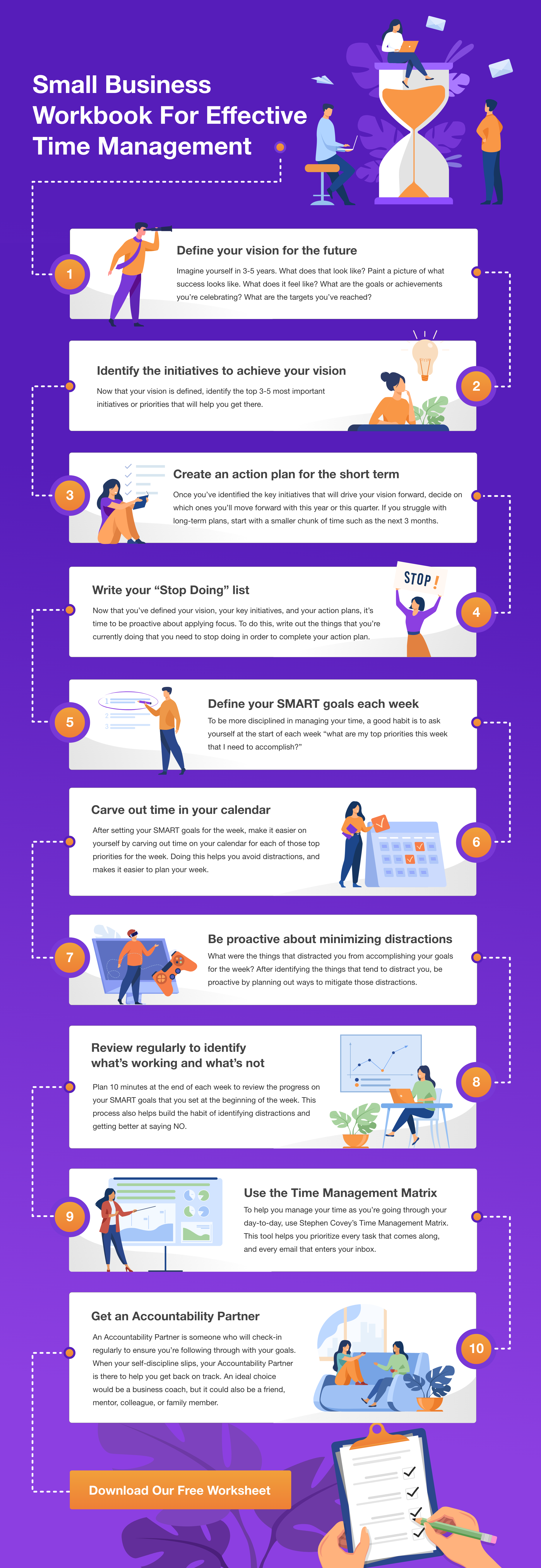
1. Define your vision for the future
Imagine yourself in 3-5 years. What does your small business success story look like? Paint a picture of what success looks like. What are the goals or achievements you’re celebrating? For example, if you’re writing your vision for your company 3-5 years from now, you may want to think about how many customers you have, how much revenue your company is generating, how many employees you have, what customers are saying about your business, etc. To do this, write down bullet points for what that looks like. Try to be as specific as you can. Doing this will help you clarify where you’re going and be more focused on your long-term goals and prioritize what you need to do to get there.
Your 3-5 year vision could look like this:

Download our free customizable time management worksheet to serve as your all-in-one worksheet. Each of the breakout sections has been thoughtfully housed within a single worksheet, ensuring convenience and ease of use, eliminating the need to navigate through multiple pages.
Pro Tip: After writing your bullet points, craft a compelling story. By writing your vision in a few paragraphs, it will help you visualize and get excited about what that feels like. An example of a compelling story about your vision could start like this: It’s the year 2025 and [my company name] has been named one of top Wedding Photographers by [journalist/site] for creating interesting and beautiful photograph, while providing a 5-star client experience.
2. Identify the initiatives to achieve your vision
Now that your vision is defined, identify the top 3-5 most important initiatives or priorities that will help you get there. Perhaps you need to revisit your marketing strategy in order to stand out from your competition. Or maybe you need to revamp your internal processes to be more efficient to reach your revenue-per-employee targets. It’s best if you keep this list short. By doing this, it will help you stay focused on moving your key initiatives forward, and will make it easier to say NO to other good ideas and opportunities that are distractions from your vision.
Sample initiatives that could drive the vision:
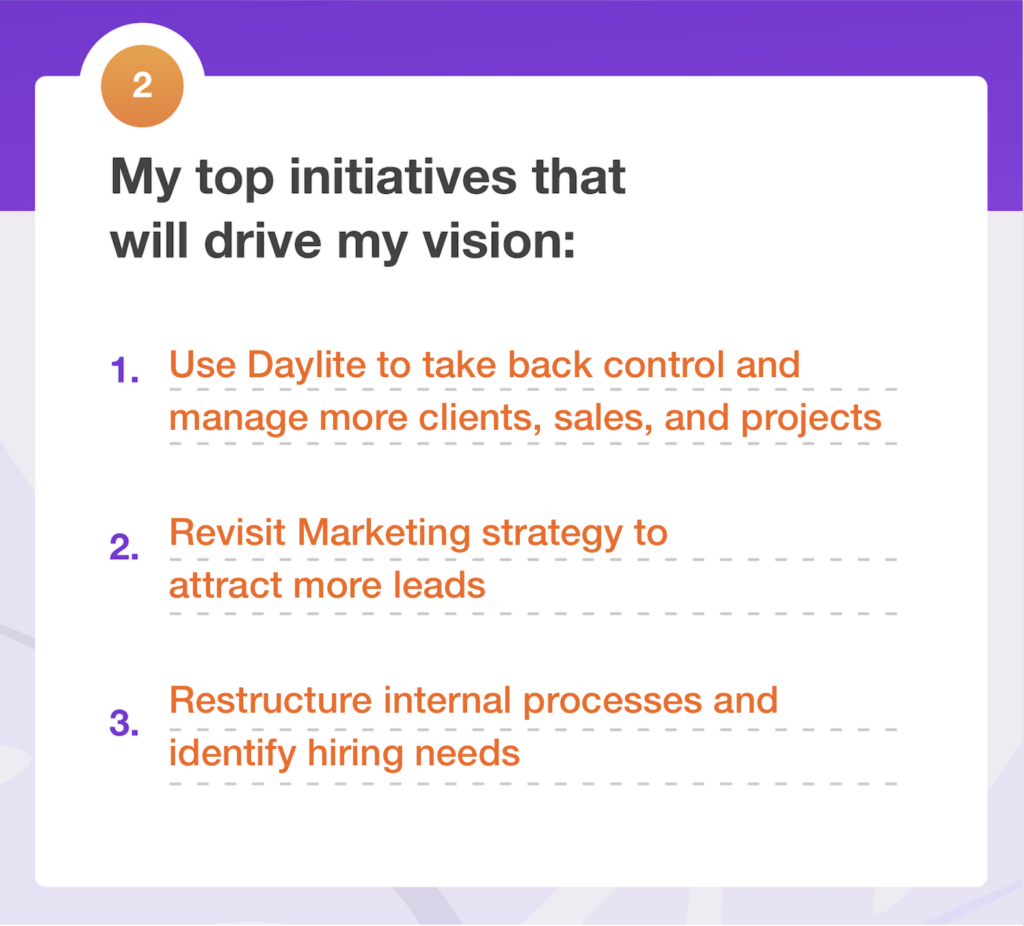
Pro Tip: Define each initiative with a bit of detail and a measure of success so when you refer back to it, it will help you identify whether or not it needs tweaking and will help you remember the context. For example, one of your key initiatives may be to invest in providing the best client experience possible. This could be broken down into a few things such as investing in CRM software to improve your client relationships or doing regular client surveys for feedback on how to improve, etc.
3. Create an action plan for the short term
Once you’ve identified the key initiatives that will drive your vision forward, decide on which ones you’ll prioritize this quarter. For each initiative, create an action plan for the quarter with a definition of the purpose, what success looks like. At the end of the quarter, measure the success, and the key milestones. Doing this exercise will guide you what’s most important to achieve your strategic vision.
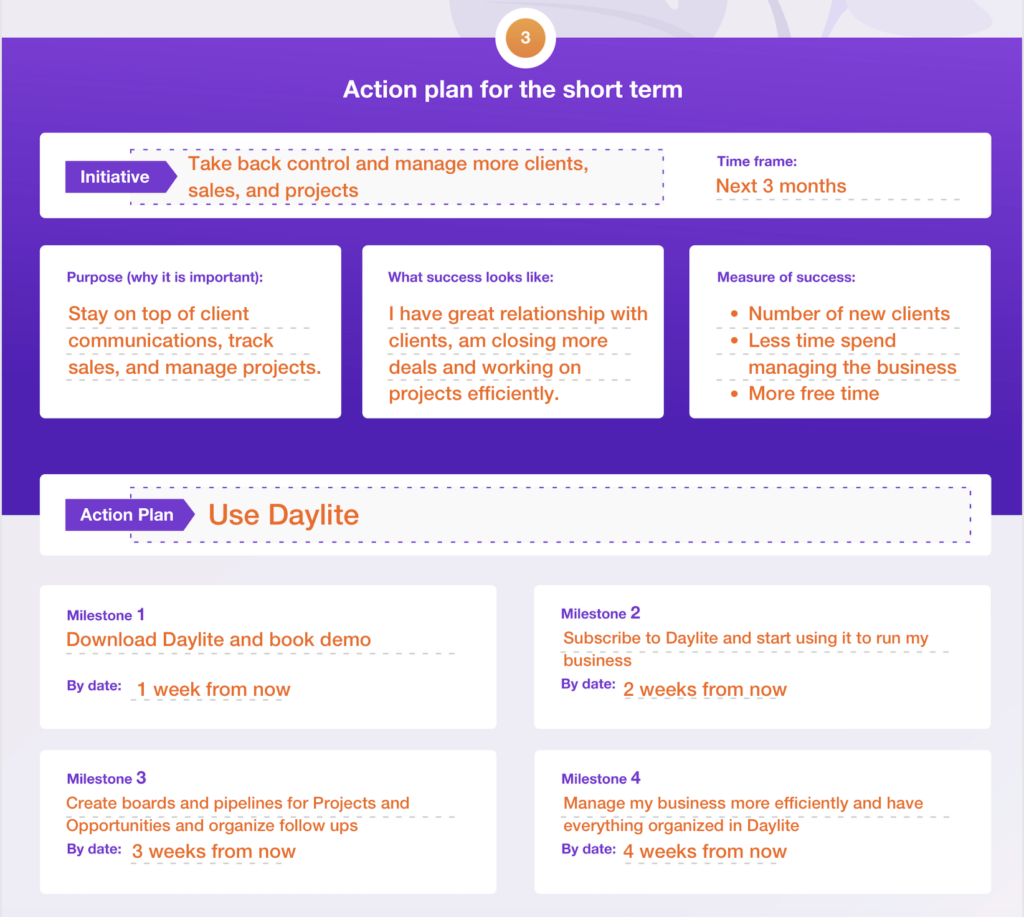
4. Write your “Stop Doing” list
Now that you’ve defined your vision, key initiatives, and action plans, it’s time to be proactive about applying focus. To do so, start with a “stop doing” list, where you write out the items that you’re currently working on but that are not helping you be productive and complete your action plan.
- What are the things that you do that keep you from achieving these targets?
- What are the tasks that have minimal value or impact and eat up your time?
Your “Stop Doing” list could look like this:
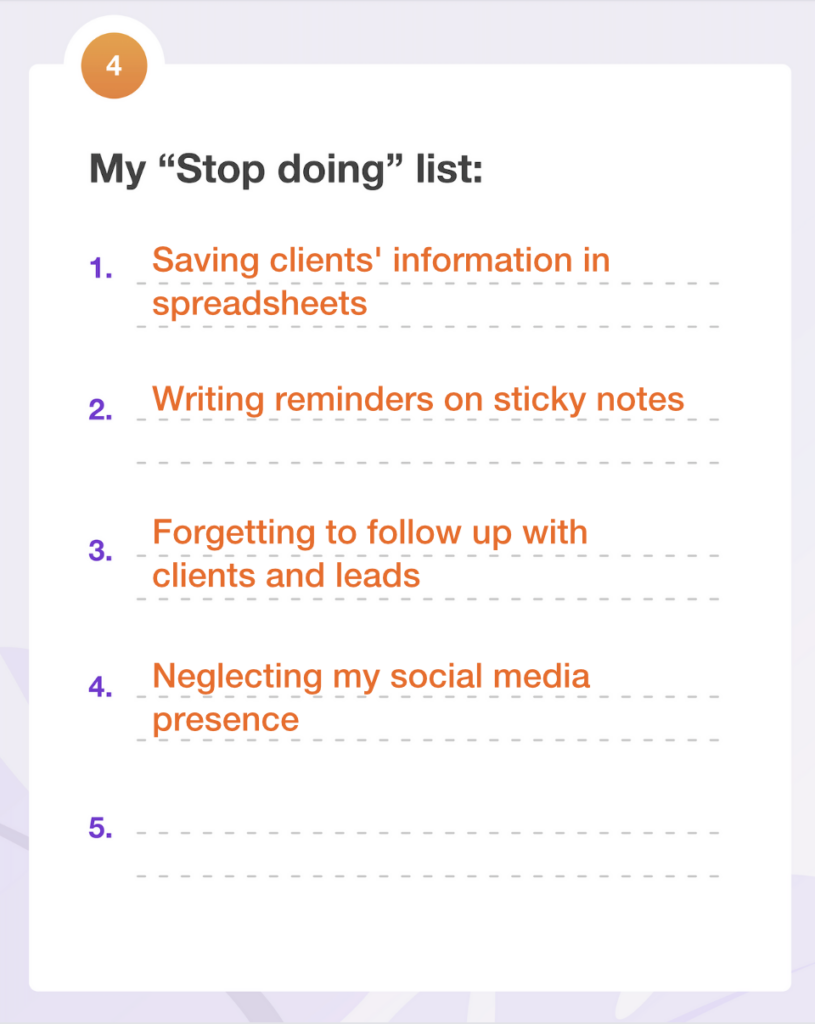
Once you have your stop-doing list written out, review this list and decide what will be delegated, automated, or ditched altogether.
5. Define your SMART goals each week
A good habit is to ask yourself at the start of each week “what are my top priorities this week that I need to accomplish?” Is there anything that needs to be done this week to reach your milestones? It’s best if you arrange this list from top priority to least, and try to keep it around 5 things or less. This is NOT just a to-do list, it’s a priority list. Meaning there will be other things that you end up doing, but they should not derail you from this list of top 3-5 most important things.
For each goal, make sure it follows the SMART goal framework:
- Specific
- Measurable
- Attainable
- Realistic
- Timely
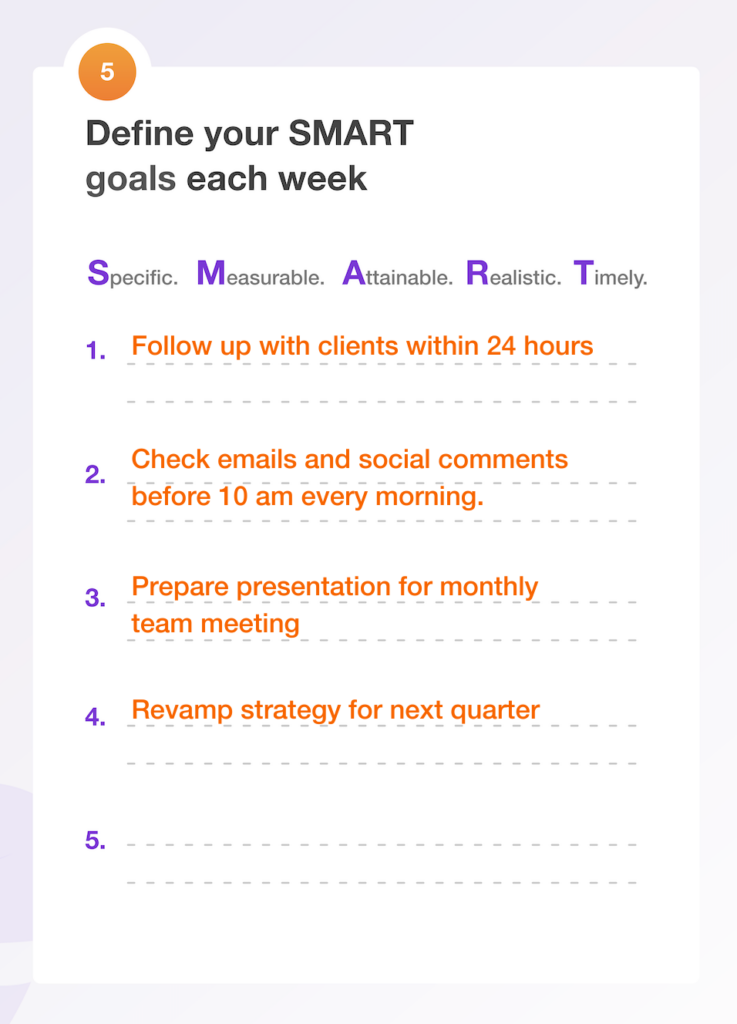
6. Carve out time in your calendar
After setting your SMART goals for the week, carve out time on your calendar for each of those top priorities for the week. Try to plan the various tasks around your most productive times. For example, if one of the tasks is to build a proposal, and you work best in the morning, carve out time in the morning to do that.
Another benefit of doing this is it will help you get better at estimating your time after applying this habit for a few weeks in a row. It also allows you to get more visibility on how you spend your time. You may be surprised that after a few weeks of incorporating this habit that you’re spending much more time than you realized on various tasks which can help you plan better in the future.
7. Be proactive about minimizing distractions
Now that you know your priorities for the week and you’ve carved out time on your calendar to do them, next comes being proactive about reducing distractions. Think about your past week.
- What were the things that distracted you from accomplishing your goals for the week?
- Was it an email? A Slack notification? Social media?
After identifying the things that tend to distract you, be proactive by planning out ways to mitigate those distractions. For example, if constantly distracted by emails, then turn off your email during the time you’ve carved out for focused work.
8. Review regularly to identify what’s working and what’s not
People are human and you won’t be perfect at achieving your SMART goals each week. But by being disciplined to review what worked and what didn’t, it will help you get better at planning your goals, better at estimating your time, and better at avoiding distractions.
To do this, plan 10 minutes at the end of each week to review the progress on your SMART goals that you set at the beginning of the week.
- Did you get all of them done?
- Was there something that got in the way?
- Was there an important priority you forgot to plan for?
- Did you underestimate how long each one would take?
Get into the habit of doing this every week to help yourself improve at goal setting.
- Did you choose the right priorities that align with your strategic vision?
- Do any of your priorities for your 5-year vision need to change?
- Did you set the right measures of success for your priorities for the week?
- Did you plan out your milestones in an effective way?
By reviewing what’s working and what’s not working, you can make the necessary tweaks and adjustments to improve and move your business forward to achieve your goals. This process also helps build the habit of identifying distractions and getting better at saying NO.
Pro Tip: To help you build this habit, schedule time in your calendar at the end of the week, once a month, and once a quarter so you remember to do it.
9. Use the Time Management Matrix
To help you manage your time as you’re going through your day-to-day, use Stephen Covey’s Time Management Matrix.
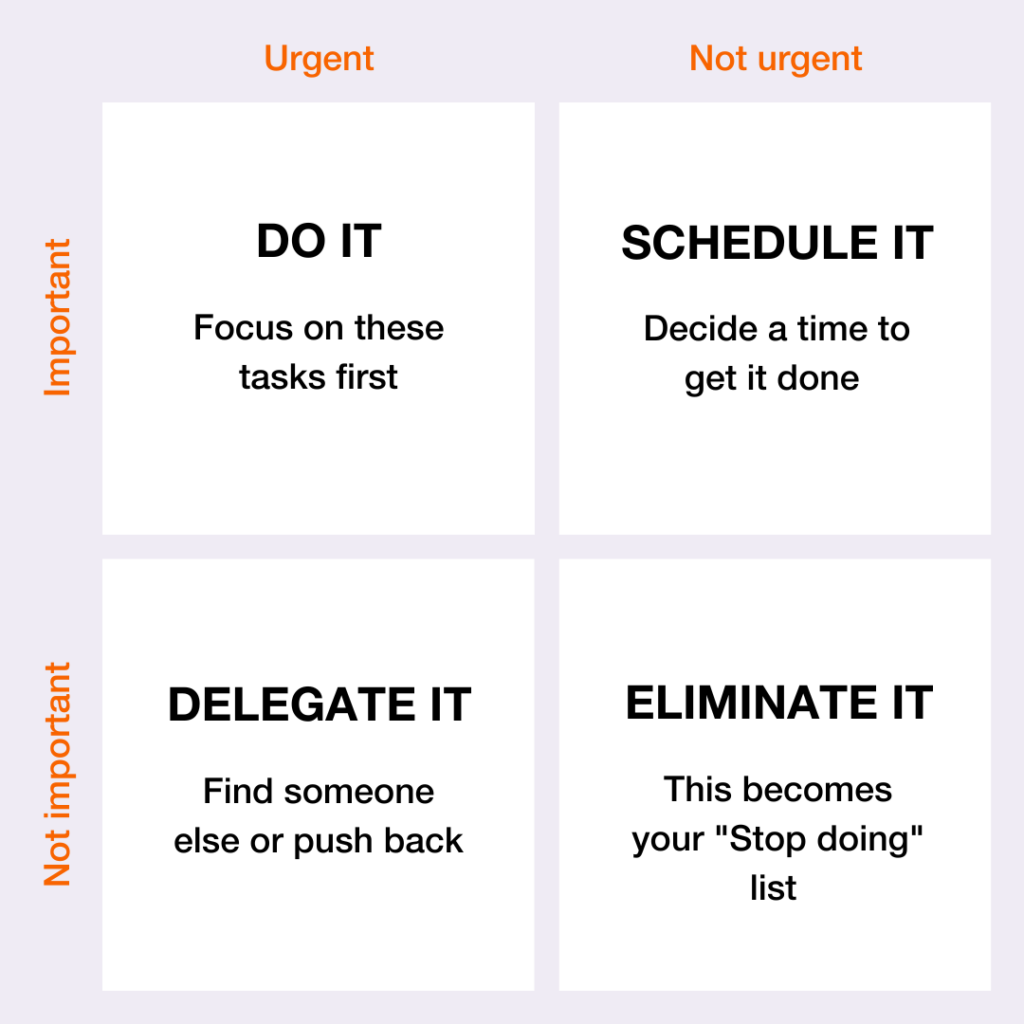
This tool helps you prioritize every task that comes along, and every email that enters your inbox. This is done by evaluating its importance and urgency then plotting it on the quadrant and, based on where it lands, deciding whether to do, delegate, defer, or ditch it.
10. Get an Accountability Partner
Even when you have your vision, priorities, action plans, and all these techniques to help you manage your time more effectively, it can still be easy to let things slip and fall back into your old habits. When you’re the business owner, you don’t have a boss that’s checking in with you to make sure you’re following through with your time management strategies. Having an Accountability Partner can help you stay on track.
What is an Accountability Partner?
An Accountability Partner is someone who will check-in regularly to ensure you’re following through with your goals. When your self-discipline slips, your Accountability Partner is there to help you get back on track.
How do you choose an Accountability Partner?
The Accountability Partner should be someone that will follow through with calling you each day or week, and will be tough on you to hold you accountable, when necessary. It should also be someone you trust. An ideal choice would be a business coach, but it could also be a friend, mentor, colleague, or family member.
Conclusion
By following these 10 steps and techniques you won’t magically become a superhero, but you may feel like one. You’ll be surprised by how much time you wasted on distractions or unimportant things that felt like a priority at the time but are in fact not important to your long-term vision.
Download our free customizable time management worksheet that you can either fill out digitally or print out to use as an action plan for improving and creating sustainable time management habits.
About the author: Thanny Schmitz is a seasoned copywriter and content strategist passionate about technology and entrepreneurship. With over a decade of experience, Thanny has been behind insightful articles and blogs that inform and spark meaningful conversations within the ever-evolving spheres of tech and small business success.

